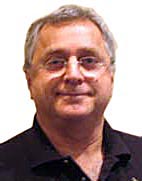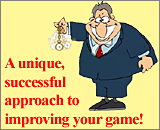 |
Tournaments
 |
|
|
|
How to Make Tournaments More Fun
| |
by Phil Simborg, 2007
|
|

|

|
I'm sorry if I sound like a killjoy, but as much as I love competing at backgammon tournaments, I have really gotten bored with them after several years of competing. They are all pretty much the same and they could all be a lot more fun and interesting with a few changes. Here's what I would like to see:
- The matches are too long. Matches are not exciting until one or both players are close to winning. One reason why tennis is so exciting is that every 3 or 4 points there is a game point or deuce and it gets very exciting. Instead of 9, 11, or longer matches, tournament backgammon should be broken down into a series of 3 or 5 point matches. That is when the cube gets complicated, and checker plays start becoming more complex because of the score. And that would also make the game much more exciting for spectators and players. The first rounds of a major tournament should be best 3 out of 5 matches to 3 points, and in the semis and finals, best 3 out of 5 to 5 points.
- Consulting doubles is silly. It's slow, and the lower-ranked player is nothing more than a robot. If the players are about equal, the discussions are tiresome and boring. True doubles should be each player making every-other move, with no consulting. Cube consulting is fine. I've played this way many times, and it works well and is very exciting.
- The Calcutta is long and boring. And when the tournament director sets up teams that are fairly equal, most of the time it doesn't matter who you buy ... it's just a guess. The system we used in Peoria where the winning bidder gets to make up his team by choosing from column A and B is a lot more interesting and fun, and it even allows you to pick your own teammates if you win the bid.
- Better side events. Side events should be really fun and interesting and challenging. Backgammon-to-lose**, Nackgammon***, and Sassoongammon* are really fun. A poker event or gin event or hearts tournament or Scrabble as a side or special event would be great fun and attract many players and spectators.
- Different formats are fun. Almost all the players enjoy the Swiss movement. Some tournaments allow buy-backs, and others have double-elimination. The more variations and different formats the better.
- Better scheduling. Scheduling should allow for time to see whatever city you're in. Saturday night should be left completely open to see the town and have some fun, and there should even be some planned outings and events to chose from.
- Good food and good hospitality. Pittsburgh proved that people don't mind paying an extra $20 for the availability of good food and treats during the tournament. People pay all kinds of money for hotel, air, and the entry fee ... .what's another $20 or even $30 per person to have great hospitality for all?
- Clocks. Clocks should be either used fully at every tournament, or there should be many available for the director to use whenever matches start lagging. Sitting around waiting for slow players greatly detracts from tournament enjoyment. (And for sure, clocks should be required in doubles events!)
- Money. There are players that really like to gamble and enjoy the money aspects of the game, and there are others who either don't enjoy or can't afford that aspect of the game. I believe entry fees should be smaller to attract more players, but there should be graduated side pools so that people who want to gamble more can do so. For example, the Open entry fee could be $200, and players could opt to get in side pools of $50, $100, and $200. (If you enter the $200 you are automatically in all three pools, and if you enter the $100 you are in two pools.) Children under 18 should be allowed to enter any division for half price. And the novice division should be only a nominal fee with no prize money, just trophies for the winners.
- Improve the point system. The point system currently only rewards people who cash (semis and up and first consolation). It is very tough to cash in a major event. Points should be awarded for every match won, and of course, more points should be awarded in the main flights, and bonus points for matches won in the semis and finals. With computers, there should be no problem keeping track of the points, and I guarantee you that more people will attend more tournaments just to see their yearly and lifetime points grow. One need only look at Contract Bridge, where players travel all over the world and spend thousands of dollars on lessons and professional partners just to win points. We could also consider designations such as Life Master as the do in bridge.
- Broadcast the finals. All finals should be broadcast on the Internet or via Webinar. We have the technology to do that very inexpensively, and players from all over the world can watch every finals event at every major tournament. With expert commentary, this could greatly increase the excitement and interest of the game.
| * |
Sassoongammon is a fun variation where the player rolls 3 dice and the opponent chooses which 2 of the 3 will be used. I recommend some variations where you stop doing this when there is no contact and just play with 2 dice from that point on.
|
| ** |
I really like backgammon-to-lose a lot. For the first three turns for both sides, you play as bad as you can. Then you change sides (turn the board around) and play as well as you can from there. You will find yourself in extremely unusual and interesting positions and will have to be very creative to win.
Several tournaments have tried my Simborg Rule in side events. The rule states that you cannot make a point on the opening roll, or if you roll 6-5 on the opening roll, you cannot run one checker. This takes away the huge advantage gained by some opening rolls and causes the game to be more complicated from the start.
|
| *** |
Nackgammon is also a fantastic game (start with 4 checkers back instead of two, with checkers on the 23 and 24 points) as this causes the game to be very complicated.
These variations are not only fun, they require the players to be creative and play from positions and situations that are unfamiliar.
|
|
|

Return to:
Backgammon Galore
|
|
|
|

